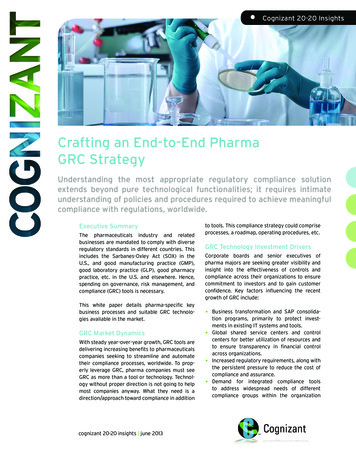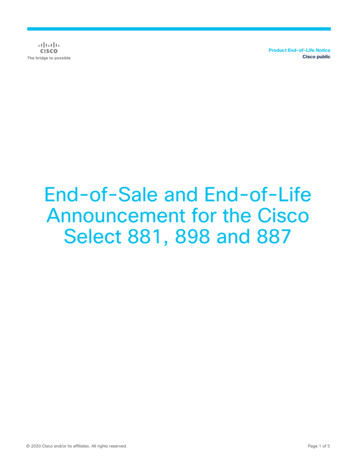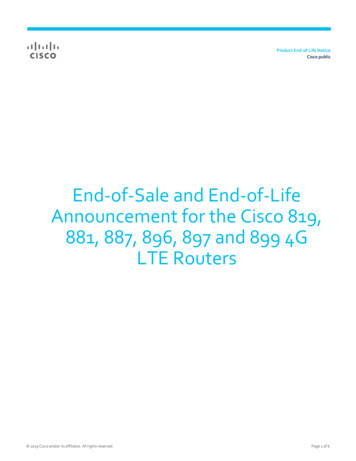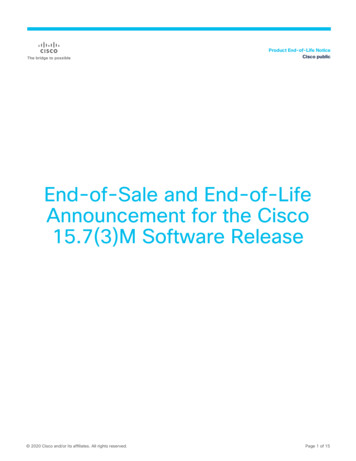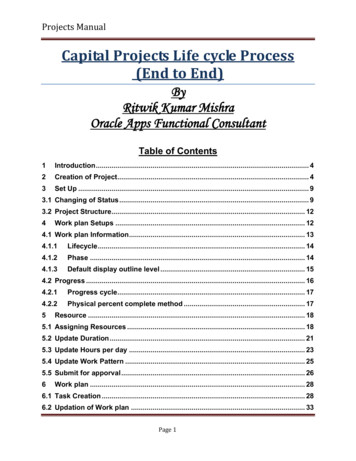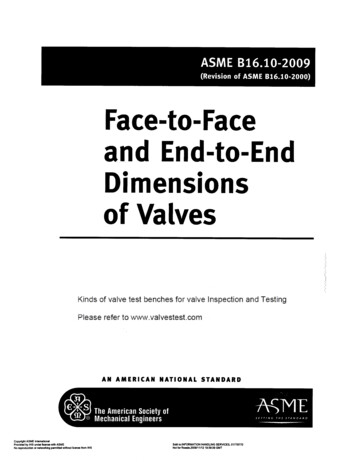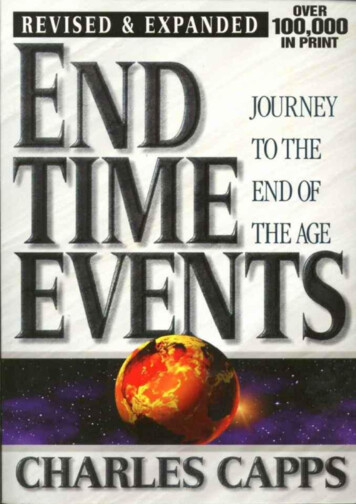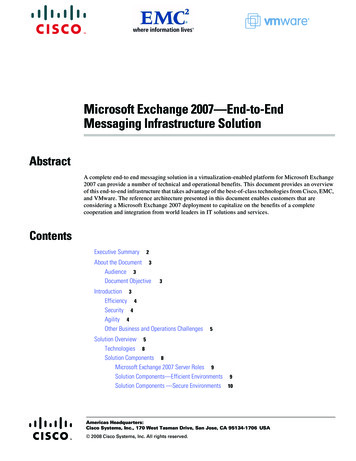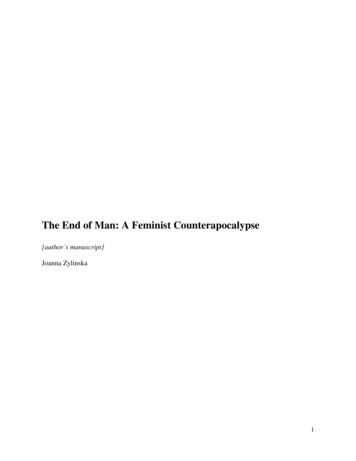
Transcription
The End of Man: A Feminist Counterapocalypse[author’s manuscript]Joanna Zylinska1
ContentsFirst as Tragedy Apocalypse, Now!Man’s Tragic WorldviewMen Repair the World for MeProject Man 2.0Exit ManThe End of the White ManThe End of Men?A Feminist Counter-apocalypseCoda: Sensing the AnthropoceneAcknowledgmentsNotesBibliography2
First as Tragedy The End of Man: A Feminist Counterapocalypse offers an ironic take on one of the dominantapocalyptic narratives of our times. The prophecy contained in the book’s title ostensibly pointsto the extinction of the human species, yet it also signals the expiration of the White ChristianMan as the key subject of history. Embracing the spirit of the Forerunners: Ideas First series inits speculative mode and lighthearted style, this short book arises out of my recentinterventions—conference papers, panel discussions, and artistic engagements—into theplanetary crisis that embraces the environment, economy, politics, and life itself. Specifically,The End of Man offers a challenge to the widespread belief that salvation from the currentplanetary apocalypse will come from a secularized yet godlike elsewhere: an escape to heavensin the form of planetary relocation, or an actual upgrade of humans to the status of gods viaArtificial Intelligence. Such solutions from elsewhere are currently being proposed by scienceand technology but they are also very much part of our political landscape. As well as lookingsuspiciously at various technocratic promises coming from Silicon Valley, The End of Maninterrogates the current rise in populism worldwide, which is evident in the turning to the antiexpert solutions offered by self-proclaimed saviors from outside the political mainstream. Inresponse, the book offers a vision of a “feminist counterapocalypse” that, in adopting precarity asthe fundamental condition of living in the global post-industrial world, contests many of themasculinist and technicist solutions to the said crisis.Apocalypse, Now!More broadly, The End of Man is designed as a critical intervention into what is currently beingtreated as a defining concept of our times: the Anthropocene. Posited as a new geological epoch3
in which human influence on the geo- and biosphere has been irreversible, the Anthropocene hasbecome a new epistemological filter through which we humans can see ourselves. It has alsotriggered the production of multiple images and narratives about ourselves and about the worldaround us. The Anthropocene is often presented as a consequence of the excessive use of theresources of our planet, whereby seemingly interminable growth eventually leads to depletion,scarcity, and the crisis of life in its biological and social aspects. The term encapsulates not just“peak oil,” “peak red meat,” “peak growth,” and “peak stuff,”1 but also, more ominouslyperhaps, “peak man.” The Anthropocene is therefore a story about a presently unfoldingplanetary emergency that affects both rich and poor regions of the world—although not all ofthem with the same impact or intensity. Yet it is worth pointing out that the apocalyptic tropesthat underpin the Anthropocene narrative have actually been reoccurring through Western (andnon-Western) cultural history—from pre-modern religious texts such as the Epic of Gilgamesh,the Book of Daniel, and the Book of Revelation (aka the Apocalypse of St. John), through tocontemporary cultural productions such as Federico Fellini’s La Dolce Vita, Margaret Atwood’sdystopian novels including The Handmaid’s Tale and MaddAddam, and TV series such asSurvivors and The Walking Dead. Critic Frank Kermode has pointed out that “[a]pocalypse andthe related themes are strikingly long-lived,” while theologian Catherine Keller has gone so faras to suggest that “we stand in an unfinished history of apocalyptic finalities.”2At the same time, the reoccurring apocalyptic narrative, in all its deadly guises, hasacquired a new lease of life and a new sense of direction after becoming linked to theAnthropocene. Although the latter term has only gained currency in scientific and populardebates in the last few years, the beginning of the Anthropocene epoch is variously dated to theearly days of agriculture, the launch of the Industrial Revolution in the eighteenth century, and4
the “great acceleration” of population growth and energy use in the years after 1945. Human andnonhuman extinction, and the destruction of life as we know it on our planet, loom as theendpoint of this epoch. Interestingly, the inflection of this particular apocalyptic narrativechanges depending on who is telling the story. For example, the concept of the Anthropocenecan be used to establish an inherent link between capitalism and the modern way of life,3 andthus alert us to the injustices of the ever-encroaching neoliberal market logic that has nowabsorbed nature and climate under its remit. But it can also be mobilized to praise humaningenuity and problem-solving skills, and to promote capital-driven solutions to climate change,such as nuclear fission, carbon-offsetting, and geoengineering.4 Scientists still have notunequivocally agreed that the declaration of a new epoch is warranted, yet the Anthropocene hasalready been renamed by cultural and political theorists as the Anthrobscene, the Capitalocene,the Chthulucene, the Eurocene, the Plantationocene, and the Technocene, by way of challengingthe inequality and injustice the original name was said to perpetuate. So even though we arenowhere near solving the climate issues, in some areas of critical theory we already findourselves post-Anthropocene, it seems.5My own critical intervention involves delving into this knot of material processes,objects, and meanings that have accrued around this term in recent years, in a variety ofacademic disciplines and in the wider cultural and media landscape. Rather than attempt to offerlarge-scale solutions to global ecological problems, or even undertake a detailed critique of thevarious positions on the Anthropocene that have emerged from different intellectual and politicalquarters, my aims in this book are more modest. I am interested predominantly in exploring the“structures of mourning”6 that the Anthropocene has both drawn upon and ushered in, as itsaffective framework and intellectual foundation. My focus is on the aforementioned “peak man,”5
the impending population excess that is said to be putting unbearable constraints upon our planetand that is consequently being posited by some as a harbinger of the end of the human species.Tracing the apocalyptic undertones of the Anthropocene story as a story of the existential crisisof humanity, I want to look at a number of recent developments surrounding the human both as aphilosophical concept and as meaty materiality: the panic about the scarcity of resourcesavailable to sustain us; concerns over the aging of populations; renewed activity around ArtificialIntelligence (AI) on the part of Silicon Valley researchers and investors; biotechnology researchinto ways of upgrading the human all the way to immortality. Last but not least, I want to locatethe recent turn to the Anthropocene as an explanatory concept against the horizon of variouscurrent political events across the globe: the war on terror, the rise of rightwing populism, therefugee crisis, the Trump phenomenon, Brexit.With all these different conceptual threads and points of enquiry, what I am concernedabout first and foremost are the unspoken anxieties, desires, and fantasies that the finalismdenoted by the “end of man” prophecy linked with the Anthropocene implies. I want to payparticular attention to the gendering of the Anthropocene story, with a view to querying some ofits foundational assumptions and underpinning structures. Through this, I aim to take some stepstoward sketching a different narrative for the human subject who, once again, finds himself onthe precipice of time. I also wish to engender a more anchored, more embodied, and morelocalized sense of response to, and responsibility for, the milieu we earthlings call home. “Theend of man” pronounced as part of the current apocalyptic discourse can therefore be seen asboth a promise and an ethical opening—rather than solely as an existential threat. If theAnthropocene names a period in which the human is said to have become a geological agent, myplan is to cut through some of the sedimented layers of meaning that have already accrued6
around the Anthropocene—and to carve a better, more responsive and more responsible, pictureof ourselves, here and now.Ultimately, the goal of the book is to break what Keller has termed “an apocalypsehabit.” This habit manifests itself in a “wider matrix of unconscious tendencies”7 that shapefinalist thinking, with its moralistic underpinnings, whereby moralism comes at the expense ofthe analysis of power relations on the ground. My method involves working through and acrossvarious academic and popular narratives on the Anthropocene. Temporally, The End of Man is afollow-up to my earlier book, Minimal Ethics for the Anthropocene,8 but it is also a parallel oreven an alternative project. While it shares with the previous volume the conceptual spectrumand the minimalism of form, as well as a desire to make a critical intervention into debates aboutthe world in all its geophysical formations, The End of Man also offers a different pathwaythrough the Anthropocene debate. This path does not lead so much via philosophy and ethics, butrather traces the adaptation and transformation of philosophical ideas in a broader set of culturalscripts: journalism and wider media debates, sci-tech industry narratives, explicit and implicitreligious beliefs, political events.Man’s Tragic WorldviewApocalyptic thinking is an aspect of what has been termed “the tragic worldview”: a cognitiveframework that stands for the human’s ability to reflect on life’s finitude, coupled with thehuman’s inability to come to terms with this finitude. This tension between cognitive statesevokes a sense of tragedy in the human, with apocalypse becoming a symptom of thinking intragic terms. Citing historian of religion Mircea Eliade, Polish philosopher Wojciech Załuskiclaims that the tragic worldview, which is still with us, superseded the prehistorical mental7
schema linked with the early cosmic religions. In that originary schema the human experiencedhim- or herself as an undifferentiated part of nature, with death being sensed as just a temporaryand insignificant disturbance within the ongoing permanence of life. Then, through the historicalprocess of individuation, the human gradually became separated from the natural world, whilealso learning to grasp the discontinuity of life—both human and nonhuman. For Załuski, aconservative Catholic thinker, the tragic worldview thus presents itself as a logical consequenceof the human’s separation from nature. The tragedy arises out of the impossibility of reconcilingthe appreciation of life in an amoral sense, i.e., the ability to experience wonder and admirebeauty as such, with the inability to hold on to those sensations—and to the objects from whichthey arise. The sense of the world’s evanescence is thus a cornerstone of the tragic worldview.9The tragic worldview arguably manifests itself in the fatalism of Homer and other ancientGreek thinkers, but it also returns, in a modern guise, in the Dionysianism of Friedrich Nietzscheas well as the existentialism of Jean-Paul Sartre and Albert Camus. Significantly, the pre-tragicworldview associated with early naturalistic religions, and with alternative cosmologies thatWestern thought subsequently deemed “primitive,” has never been entirely superseded: it hasbecome manifest in philosophies as diverse as Epicurean hedonism, Stoicism, and Buddhism.Yet Załuski, in his attachment to his own religious framework, sees the transition from thecosmic to the tragic worldview as a sign of the maturation of the human mind, and thus as ateleological process of growth and progression beyond the state of nature. The philosophy ofimmanence developed, for example, by Gilles Deleuze would therefore be seen as immaturefrom a particularist Christian viewpoint. Indeed, for Załuski, the process of human maturation asa species entails the gradual discovery of an authentic human condition—which is the conditionof the fall from grace, or separation from God as the fullness of being. The very existence in, and8
care about, the world on the part of the human can only be apprehended in the course of history.The inherent tragedy of human existence resulting from its finitude is ultimately redeemed inChristianity by the promise of eternal life.It is worth analyzing the conservative finalist discourses, especially in their Biblicalarticulations, because many of their tropes and figures return in the dominant narratives on theAnthropocene—notwithstanding the latter’s apparent secularism premised on scientificrationality. And thus, when the sixth seal of the divine scroll is broken in the Book of Revelation,it unveils the wrath of God by proclaiming the total destruction of the stable planetaryconfiguration, with all humans, irrespective of their wealth and status, rushing to hide from thecatastrophe amidst the ensuing rubble:[T]here was a great earthquake; and the sun became black as sackcloth of hair, and themoon became as blood;And the stars of heaven fell unto the earth And the heaven departed as a scroll when it is rolled together; and every mountain andisland were moved out of their places.And the kings of the earth, and the great men, and the rich men, and the chief captains,and the mighty men, and every bondman, and every free man, hid themselves in the densand in the rocks of the mountains 10The sense of total annihilation is nevertheless overcome in the Book of Revelation by thepromise of the New Heaven and Earth, or the New Jerusalem, with the river of life revitaliz
non-Western) cultural history—from pre-modern religious texts such as the Epic of Gilgamesh, . endpoint of this epoch. Interestingly, the inflection of this particular apocalyptic narrative changes depending on who is telling the story. For example, the concept of the Anthropocene can be used to establish an inherent link between capitalism and the modern way of life,3 and thus alert us to .
